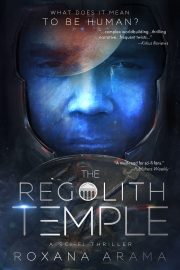Butchness and Liminal Mortality in SF
by Hannah Abigail Clarke
In the opening credits of Zach Snyder’s Watchmen, the phrase LESBIAN WHORES is briefly scrawled in blood on a wall. The lesbian couple from whom said blood was extracted lie adjacent, lifeless in lingerie. The lesbians here exist to display death. Death binds the lesbians to this opening credit spot, allowing the plot to roll on, unfettered by lesbianism’s potential ramifications—flashiness, campiness, demanding provocations—while still allowing the audience a lick of pulp erotic horror. LESBIAN WHORES is a particularly loud example of Dead Lesbian Syndrome, a trope pervasive in and beyond SF/F in which sapphic characters face their mortality seemingly at random and with little narrative payoff, and is incidentally the first time I can remember actually reading the word lesbian. I was twelve. This remains a pervasive narrative stasis.
Still, stasis ruptures and has been rupturing. Despite the scarcity of lesbian protagonists, particularly of the butch/gender nonconforming/nonbinary variety, SF has decorated examples in Tamsyn Muir’s ongoing Locked Tomb trilogy and Joanna Russ’s Whileaway stories, “When It Changed” and The Female Man. Lesbian death is omnipresent in these texts, but rather than being a device to shut down narrative potential, lesbian proximity with death becomes a driving, prose-warping force that generates its own kind of narrative structure. It is also noteworthy that Russ’s work does venture into transphobia, and its understandings of lesbian-specific gender tension aren’t verisimilar to many of today’s gender conceptions.
Spoilers henceforth abound.
In Russ’s “When It Changed,” Whileaway is a lesbian utopia in which men have not existed for thirty generations. Then men show up, and the narrator knows at once that she will die, and that lesbian utopia is transient, ephemeral, mortal. Whileaway’s original name was For-A-While. Death is a promise embroidered on lesbian utopia’s foundations. Whileaway resurfaces in The Female Man as a place existent in one of several concurrent timelines, the home of one of several concurrent genderweird lesbians who might all be the same lesbian despite being radically different lesbians. The plot structure doesn’t arc so much as corkscrews between perspectives. Timelines tangle, worlds exchange. With “When It Changed” preceding, the discordant perspectives feel like neural fireworks before the system goes dark. It’s hilarious and devastating at once, stuffed thick with campy pulp tropes and brutality so jarring it’s almost comic. The book ends with a list of goodbyes. Literal goodbyes—goodbyes to the lesbians, to the reader, to the book itself. “Do not get glum when you are no longer understood, little book…For on that day, we will be free.”
Fifty years later, we have Gideon the Ninth and Harrow the Ninth, which is to say, Joanna Russ and her little book are not yet free. Necromancy is The Locked Tomb’s primary conceit—the worldbuilding in all its pomp is predicated on a mass accumulation of death that permeates every aspect of the characters’ lives, perhaps recalling Whileaway’s origins as a place that exists because all men were slaughtered in a sex war generations previous. When our butch dies, she also doesn’t die, and instead floats in liminal existence within the body of the lesbian who ate her. Harrow claws through a barrage of today’s campy pulp tropes, i.e. fanfiction tropes, looking for the semi-dead dyke in her head—a role reversal, a courtship ball, a coffee shop AU in imperial colors—and spirals through delusions of alternate timelines, fractured perspectives, a familiar mix of comedic genius and stomach-churning violence. The lesbians maybe die again. We get a brief goodbye.
These texts make no motion to overlook or wish away Dead Lesbian Syndrome. They make a tool of it. Where Dead Lesbian Syndrome forecloses the potential for lesbian stories to unfold, these texts use death as a crowbar to pry open narrative structure itself and make lateral space for all manner of lesbian nonsense. Bending space and time is an SF staple, but the particular method of plot scrambling in both The Female Man and Harrow the Ninth feels distinct. There’s a bracing, bitter humor about the absolute smithereens we’re left with in the wake of these books. There is little closure and only brief gasps of catharsis. We have few answers beyond a recognition of pain.
We who write queer SF/F are left with this: as much power exists in stories that imagine radical futures beyond queer trauma as it exists in stories we hope will be irrelevant soon. Stories like these affirm the brain-splitting aftereffects of pain, both fresh and long accumulated, as being worthy of narrative. Reckoning can be requisite for escape.
Hannah Abigail Clarke is here and queer, etc. They’ve been published at Tor.com, Lunch Ticket, PRISM international, Dream Pop Press, Portland Review, Gothic Nature Journal, Eidolon, and Chaleur Magazine. They were a 2019 Lambda Literary Fellow in Young Adult Fiction and a Pushcart nominee. The Scapegracers is their first novel.


